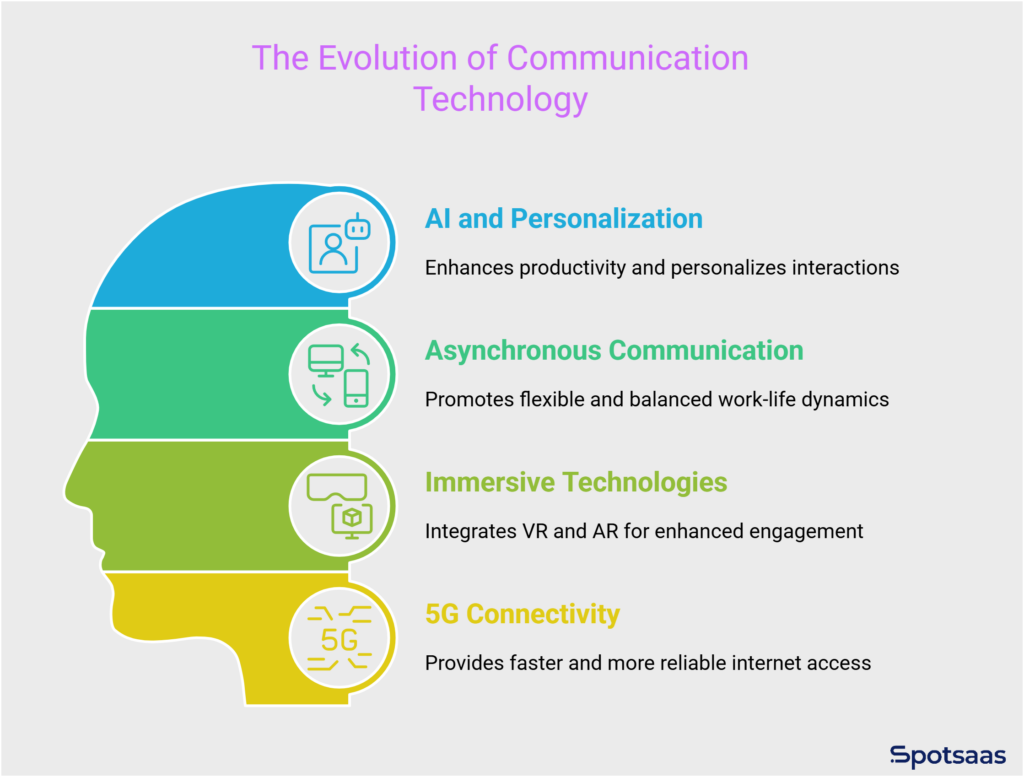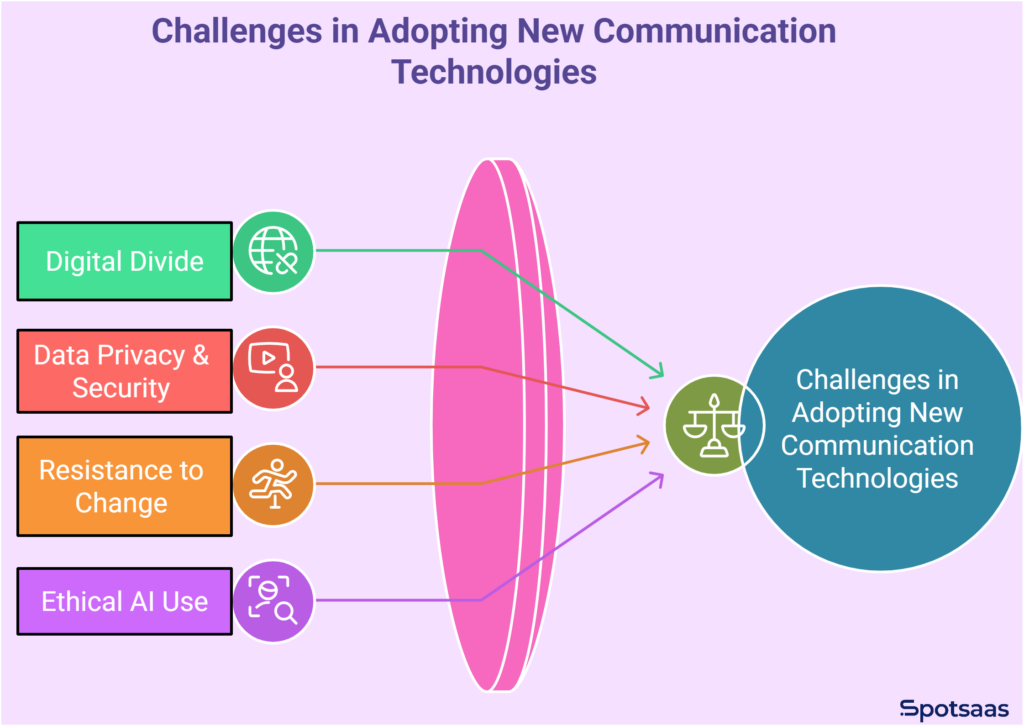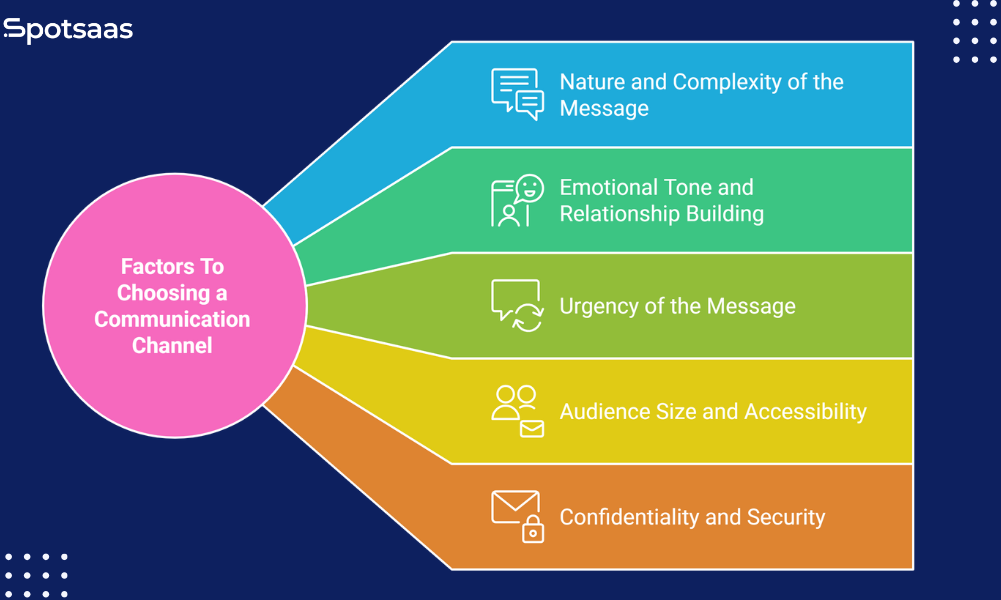Communication has transformed significantly in recent years. The rise of AI, immersive technologies, and real-time connectivity has changed how people interact.
Businesses, employees, and consumers now expect instant, seamless, and personalized communication across multiple channels. The question is no longer about whether technology will shape communication, but how it will continue to evolve in ways that enhance efficiency, collaboration, and engagement.
This blog will demystify communication channels and shed light on how technology enhances them.
Key Takeaways
- Communication is evolving with AI, VR, and decentralized platforms replacing traditional methods.
- AI-driven personalization is making interactions smarter but raises privacy concerns.
- Emerging technologies like brain-computer interfaces and quantum messaging are shaping the future.
- Challenges include the digital divide, cybersecurity risks, and resistance to AI adoption.
- Balancing innovation and human connection is key to meaningful communication.
What Are Communication Channels?
Communication channels refer to the mediums through which information is transmitted from one entity to another. These channels facilitate interaction between individuals, businesses, and organizations, allowing for effective message delivery.

They can be categorized based on their nature, purpose, and the technology used. Effective communication channels ensure clarity, efficiency, and accessibility, making them essential in both personal and professional contexts.
Types of Communication Channels in 2025
Communication channels in 2025 are more advanced, integrating AI, automation, and immersive technologies to enhance interaction. They can be categorized based on how and when information is exchanged.
Synchronous Communication (Real-Time Interaction)
Voice & Video Calls
Traditional calls have evolved with high-definition clarity, AI-driven noise cancellation, and real-time language translation, making cross-border communication seamless.
AI also enables real-time transcription and summarization for business calls and meetings. With 5G and satellite connectivity, call drops and lag are becoming nearly obsolete.
Virtual and Augmented Reality (VR/AR) Meetings
Remote collaboration is becoming more immersive with spatial audio and 3D avatars, creating a near-real-life experience.
VR headsets allow employees to work in virtual offices, while AR overlays can enhance presentations with interactive data. Businesses are using VR-powered training simulations to provide hands-on learning experiences in a virtual environment.
Live Chat & Instant Messaging
AI-driven chat platforms like WhatsApp, Slack, and Microsoft Teams are optimizing business and personal interactions with automated responses, smart suggestions, and chatbots that provide real-time assistance without human intervention.
These platforms now include advanced speech-to-text features and AI-generated summaries, making communication faster and more accessible.
Asynchronous Communication (Delayed Responses)
Emails & Smart Inboxes
AI is transforming email systems by automatically sorting messages, generating response suggestions, and summarizing long email threads to improve efficiency.
Features like auto-prioritization ensure that urgent messages are addressed first. AI-powered writing assistants now help draft emails in different tones and languages, ensuring clarity and professionalism.
Voice & Video Messages
Instead of traditional text messages, people are using voice and video recordings to communicate asynchronously.
These methods offer a more personal touch, better clarity, and increased convenience, especially in workplace communication. Advanced AI now provides automatic transcription and sentiment analysis, making it easier to extract key points from lengthy messages.
Workplace Collaboration Tools (Slack, Microsoft Teams, Notion, etc.)
These platforms integrate AI to automate task assignments, summarize discussions, and provide predictive recommendations for meetings and project management.
They allow teams to work across time zones without disrupting workflow. New integrations include AI-driven project tracking, ensuring real-time progress updates without the need for constant check-ins.
Social and Community-Based Communication
Social Media Platforms
Platforms like LinkedIn, Twitter (X), and emerging networks are evolving into real-time business communication hubs. They integrate AI-powered insights, live Q&A sessions, and interactive content, making them vital for branding and corporate interactions.
AI-driven content curation helps businesses and individuals engage with the most relevant conversations, boosting networking opportunities.
User-Generated Content (Short-Form Videos, Live Streams, Podcasts)
With platforms like TikTok, Instagram Reels, and YouTube Shorts, short-form videos have become the dominant communication medium.
Companies and influencers use live streaming to engage audiences in real time, providing interactive experiences and instant feedback. AI-generated captions and multi-language dubbing are making content more accessible to global audiences.
AI-Powered Chatbots & Virtual Assistants
Chatbots are now context-aware, handling customer service queries, sales inquiries, and even crisis management without human intervention.
They leverage natural language processing (NLP) and sentiment analysis to provide more human-like interactions. Advanced AI now allows chatbots to remember past interactions, enabling them to provide more personalized and meaningful responses over time.
Emerging and Advanced Communication Methods
Neural Interfaces & Brain-Computer Interaction
Early advancements in brain-to-computer interfaces allow users to communicate by simply thinking.
Companies like Neuralink are developing systems that enable thought-driven messaging and control over digital devices without speaking or typing. This technology could revolutionize accessibility for individuals with disabilities, allowing seamless communication without physical input.
Holographic Displays
Future business meetings and personal conversations may involve holographic projections, where users see and interact with life-size 3D avatars.
This technology is expected to revolutionize remote communication by bringing a physical presence into virtual interactions. Large-scale events and conferences are beginning to implement holograms for key speakers, reducing the need for physical travel.
Blockchain-Based Secure Messaging
With rising privacy concerns, blockchain-based communication ensures end-to-end encryption and decentralization, preventing unauthorized surveillance or data breaches.
Unlike traditional messaging platforms that rely on servers, decentralized communication tools store messages on peer-to-peer networks, making them more private and resistant to censorship. These platforms also prevent data tampering, ensuring complete message authenticity and security.
The Changing Landscape of Communication Technology
The changing landscape of communication technology is driven by advancements in AI, automation, and immersive experiences, transforming how people interact in personal and professional spaces.
As businesses and individuals adapt, the focus is on balancing innovation with accessibility, privacy, and meaningful engagement.

AI and Personalization
Artificial intelligence is at the core of modern communication, enhancing productivity, reducing response time, and personalizing interactions.
- AI-generated emails, predictive text, smart replies, and sentiment analysis are becoming the norm, streamlining communication workflows.
- AI-powered customer support bots can now analyze tone and intent, providing human-like responses to improve engagement.
- Smart assistants are automating meeting scheduling, summarizing discussions, and even handling basic decision-making tasks.
The Rise of Asynchronous Communication
Workplace communication is shifting toward flexibility, reducing the pressure of immediate responses.
- Companies are increasingly using voice notes, async video updates, and automated messaging to improve work-life balance.
- AI-driven platforms allow employees to consume information at their own pace, reducing unnecessary meetings and boosting productivity.
- Email management tools now use AI to filter unimportant messages, summarize long threads, and provide key action points for faster decision-making.
Immersive Virtual and Augmented Reality Communication
Virtual collaboration tools have become more advanced, integrating real-time facial expressions and spatial audio to enhance remote meetings.
- Virtual reality meetings are replacing traditional video calls, allowing users to interact in 3D spaces with customizable avatars.
- Augmented reality is playing a bigger role in industries like retail, healthcare, and education, where live interaction with digital overlays improves engagement and decision-making.
- Businesses are leveraging AR-powered remote assistance, where experts can guide users by overlaying digital instructions onto real-world objects.
5G and Global Connectivity
Faster and more reliable internet connections are eliminating network disruptions.
- Technologies like satellite-powered internet from Starlink and Project Kuiper are enabling seamless communication even in remote locations.
- High-speed 5G connectivity is making video conferencing and real-time collaboration more efficient than ever before, reducing lag and buffering issues.
- Enhanced global connectivity is bridging communication gaps, making remote work and cross-border collaboration smoother and more accessible.
As technology advances, communication continues to evolve, offering more intuitive, efficient, and immersive experiences that redefine how people connect and collaborate.
Emerging Communication Technologies in 2025
Emerging communication technologies in 2025 are transforming interactions through AI-driven conversations, brain-computer interfaces, holographic displays, and blockchain-secured messaging.
These innovations enhance efficiency, security, and immersion, making communication more seamless and personalized. They are reducing language barriers, improving accessibility for individuals with disabilities, and providing more secure ways to interact without centralized control.
AI-Generated Conversations
Advanced AI chatbots and virtual assistants can now hold natural, meaningful conversations, making automated communication nearly indistinguishable from human interaction. AI tools are also being used to generate personalized video and voice responses, improving customer service and business interactions.
- AI chatbots can analyze user sentiment and adjust their tone and response accordingly, making conversations feel more human-like.
- AI-driven voice synthesis allows businesses to create realistic digital avatars that interact with customers, providing personalized service without human intervention.
Neural and Brain-Computer Interfaces
Early developments in brain-to-computer interfaces are making thought-based communication a possibility. Neuralink and other biotech companies are exploring technology that allows individuals to send messages or control devices using only their thoughts.
- This technology could enable silent communication, allowing people to send messages or commands without speaking or typing.
- It has huge implications for accessibility, giving people with disabilities new ways to interact with the digital world through brainwave-powered controls.
Holographic Communication and 3D Avatars
Holographic projections are becoming a reality, allowing for more immersive remote meetings. Companies are investing in AI-generated 3D avatars that can participate in meetings, deliver presentations, and even interact in real-time.
- Businesses and organizations are beginning to replace traditional video calls with life-sized holograms, creating a more engaging meeting experience.
- AI-powered 3D avatars can replicate human expressions and gestures, making virtual communication feel more natural and interactive.
Quantum Communication and Secure Messaging
Quantum encryption is revolutionizing secure communication. Governments and businesses are investing in quantum-safe messaging platforms that prevent data breaches and cyber threats.
Blockchain-based messaging apps are also growing in popularity, providing end-to-end encryption without reliance on centralized servers.
- Quantum encryption ensures hack-proof messaging, making it nearly impossible for cybercriminals to intercept or decode private conversations.
- Companies are adopting quantum-safe protocols to future-proof communication security as computing power advances.
Decentralized and Encrypted Messaging Platforms
Growing concerns over data privacy have led to the development of decentralized messaging apps that eliminate third-party control over personal conversations. These platforms use blockchain technology to ensure privacy and security.
- Unlike traditional messaging services, these platforms do not store user data on centralized servers, reducing the risk of data leaks and surveillance.
- Users have greater control over their conversations, as decentralized systems prevent corporations or governments from monitoring or censoring communication.
These technologies are shaping a future where communication is smarter, more immersive, and more secure, ensuring seamless interaction across personal, professional, and global networks.
Challenges in Adopting New Communication Technologies
As communication technology advances, businesses and individuals face challenges in adoption, including the digital divide, security risks, resistance to change, and ethical concerns.
While AI, automation, and immersive tools enhance efficiency and accessibility, addressing these barriers is crucial to ensuring equitable and secure technological integration.

Digital Divide
Limited access to high-speed internet and advanced tools creates inequality in communication. Many rural and underdeveloped areas still lack the necessary infrastructure, making it difficult for businesses and individuals to adopt modern communication technologies.
High costs of smart devices and software further widen this gap. Governments and companies are investing in satellite internet and affordable technology to improve accessibility.
Data Privacy & Security Risks
AI-driven communication raises serious concerns about data security and surveillance. Many tools collect vast amounts of user data, increasing the risk of breaches and misuse.
Cyber threats such as hacking, phishing, and AI-generated scams make secure communication more critical than ever. Solutions like end-to-end encryption, decentralized platforms, and strict data protection regulations are being developed to mitigate these risks.
Resistance to Change
Adopting AI-driven workflows and automation can be challenging for businesses and employees. Some fear job displacement, while others struggle to adapt to new digital communication methods.
Traditional companies with long-established communication practices may find AI-driven systems overwhelming. Gradual implementation, employee training, and demonstrating the efficiency of new tools can help ease this transition.
Ethical AI Use
The rise of deepfakes, misinformation, and algorithmic bias presents ethical concerns in AI-driven communication. AI-generated voices and visuals can spread false information, reducing trust in digital interactions.
Bias in AI algorithms can lead to discriminatory responses in automated systems. Ethical AI frameworks, transparency in AI decision-making, and stricter policies are necessary to ensure responsible AI use in communication.
Overcoming these challenges requires a combination of technological improvements, regulatory oversight, and widespread digital literacy to ensure that communication remains accessible, secure, and reliable for all.
What’s Next? The Future of Communication in 2025 and Beyond
Hyper-Personalized AI Communication
AI will soon be able to fully understand and predict communication preferences, automating responses in a way that feels completely personalized. AI-powered digital assistants will handle business conversations, emails, and negotiations, making interactions faster and more efficient.
Brain-Computer Communication Interfaces
Brain-to-brain communication could become a reality, with early research exploring the possibility of transmitting thoughts directly from one person to another. This could revolutionize how humans communicate, removing the need for traditional devices.
Decentralized and Blockchain-Based Communication
The shift towards privacy-focused communication will continue, with more platforms adopting blockchain technology to ensure secure and encrypted conversations. Businesses and individuals will rely on decentralized networks to protect their data from surveillance and cyber threats.
Fully Immersive Virtual Workspaces
Virtual reality will evolve into fully immersive digital workspaces, allowing employees to interact in lifelike environments. AI-driven holograms and avatars will play a bigger role in remote collaboration, making virtual communication feel as real as in-person meetings.
As technology continues to advance, the challenge is not just adopting new tools but ensuring that communication remains authentic, efficient, and secure. The future will be shaped by a balance between innovation and human connection..
Factors to Consider When Choosing a Communication Channel
Selecting the right communication channel is crucial for ensuring that messages are conveyed effectively and received as intended.
Different channels serve different purposes, and choosing the most appropriate one depends on factors such as message complexity, urgency, audience, and the need for interaction.

Nature and Complexity of the Message
The type of message being communicated plays a significant role in determining the best channel.
- Complex or detailed information – Written communication, such as emails, reports, or documentation, is ideal when the message requires thorough explanations, supporting data, or reference materials. It allows recipients to review, analyze, and refer back to the details as needed.
- Straightforward or simple messages – For short, direct exchanges, instant messaging or quick phone calls can be more effective than lengthy emails.
Emotional Tone and Relationship Building
Certain communication methods are better suited for conveying emotions and fostering relationships.
- Face-to-face interactions and video calls – These channels are ideal for discussions requiring a personal touch, such as negotiations, conflict resolution, or feedback conversations. Non-verbal cues like facial expressions and tone of voice enhance understanding.
- Voice calls – When in-person meetings aren’t possible, a phone call can provide warmth and clarity that text-based communication lacks.
Urgency of the Message
The time sensitivity of communication impacts the channel choice.
- Immediate or time-sensitive matters – Instant messaging, phone calls, or video conferencing are best for urgent messages that require quick responses. These channels ensure prompt attention and real-time interaction.
- Non-urgent communication – Emails, memos, or newsletters are suitable for information that does not require immediate action, such as company updates or general announcements.
Audience Size and Accessibility
The number of recipients and their ability to access the message also influence the communication method.
- Large groups or company-wide communication – Email, intranet announcements, and digital collaboration tools like Slack or Microsoft Teams work well for reaching many people simultaneously.
- One-on-one or small group discussions – Personalized communication through direct messaging, phone calls, or small virtual meetings can be more effective for engaging specific individuals.
Confidentiality and Security
The sensitivity of the message determines how it should be communicated.
- Highly confidential information – Secure communication channels such as encrypted emails, private meetings, or specialized platforms designed for secure data exchange should be used.
- General business communication – Standard emails, internal chat platforms, and public collaboration tools are sufficient for routine discussions.
Choosing the right communication channel depends on balancing efficiency, clarity, urgency, and security to ensure the message is effectively delivered and received.
Conclusion
Communication is evolving rapidly with AI, immersive platforms, and secure messaging driving greater efficiency and personalization. However, challenges like the digital divide, cybersecurity risks, and ethical concerns must be addressed.
By selecting the right channels and striking a balance between innovation and human connection, we can ensure more accessible, secure, and meaningful interactions that empower both individuals and businesses.
As new technologies emerge, the focus should remain on fostering engagement, building trust, and ensuring everyone can benefit from these advancements.
Frequently Asked Questions
What are the main types of communication channels available in 2025?
Examples of communication channels and technologies include face-to-face interaction, videoconferencing, audio conferencing, written letters, intranet systems and mobile communication.
How is artificial intelligence enhancing communication?
AI is transforming communication by enabling real-time translations, automated transcription and summarization, smarter inbox management, and personalized chatbots that understand context and provide human-like responses.
What challenges arise from adopting new communication technologies?
Common challenges include addressing the digital divide, ensuring data privacy and security, overcoming resistance to AI and automation, and navigating ethical concerns such as bias in AI-driven interactions.
What emerging communication technologies are shaping the future?
Emerging technologies include neural interfaces that enable thought-based communication, holographic displays for immersive interactions, and blockchain-based platforms for secure, decentralized messaging.
How can businesses choose the right communication channels?
Selecting the best communication channel involves considering factors such as the complexity and urgency of the message, audience size, required security levels, and the need for real-time versus delayed interaction.



